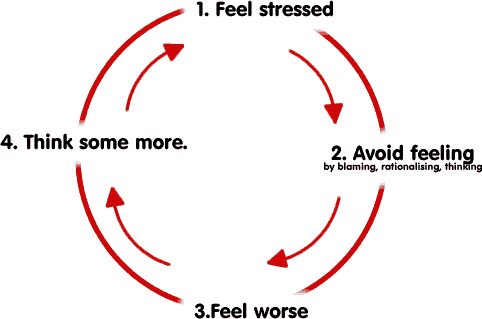7:00pm — Week 1 Review
7:25pm — How Meditation Works
The “Normal’ Mind
7:25pm — The Meditative Mind
8:00pm — Meditation: Exploring the Senses
8:20pm — Meditation 1 Debrief
8:25pm — Homework
8:30pm — Conclusion
If time permits you may like to elaborate on how sensing works to relax us, by sharing some of the following points.
- Sensing is a perfectly natural and instinctive mode of relaxation (e.g. comfort food, music, sunset, listening to waves on the beach, rain on the roof).
- Meditation just makes the act conscious, deliberate. To use the cliche – we “stop and smell the roses.”
- Interestingly it’s not what we sense that relaxes us, it’s just the increased sensory input. So there’s potential for all sorts of things, from traffic noise to the hum of an air conditioner or a ticking clock, to become objects of relaxation.
- When we sense there’s less energy available from thinking – thinking and sensing are functions that inhibit one another.
| Thinking | Sensing | |||
| is active | is more passive | |||
| involves past and future | is in the present | |||
| is complex and fast | is simpler and slower | |||
| has high emotional charge | has low emotional charge | |||
| is stimulating | is relaxing | |||
| burns energy | conserves energy | |||
| tightens the body | lets the body soften | |||
| Beta Brainwaves (13-40Hz) | Alpha Brainwaves (7-13Hz) |

Teacher Contemplations
Taken as a whole, this teaching is startling in its breadth, in the huge range of human experience that it encompasses. It shatters the picture we have of what meditation is, or how meditation teachers too often present it – as a way of dissociating from the human experience and trying to rise above it. There is not a hint of the usual life-denial which permeates and distorts spirituality East and West. This tantra is about going deeply into experience, embracing it fully, without reservation. Nature is embraced as is all of human nature. Lust and passion become fires that illumine, and gusto is taken to its most refined degree possible. Meditation is presented as the nexus or meeting ground of light and matter, spirit and flesh, and the meeting is to be consummated with great joy.
Tantric meditation is an integration of the opposites, not obliteration or mere transcendence of them. It is an alchemical union in which each exists in its fullness and in a relationship of complementarity with the other. — Lorin Roche, The Radiance Sutras.
On to Week 3 Notes.

